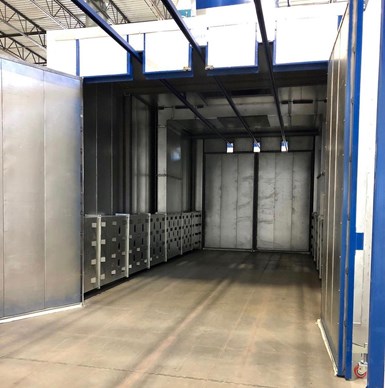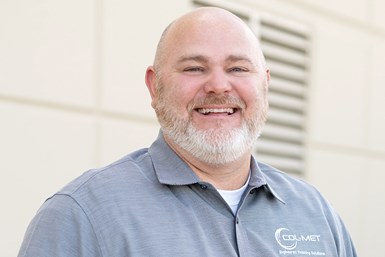Proper Powder Cure Oven Installation
Trey Peavy of RTT Engineered Finishing Solutions offers insights into considerations that must be taken into account when commissioning a powder cure oven.

Q: Is it necessary to have my powder cure oven commissioned by a trained professional?
Absolutely. As an oven manufacturer, we cannot suggest anything more critical. Even though the oven may have been factory tested, the conditions on-site may differ from the factory setting. The functionality and performance of the oven need to be adjusted for the field conditions to ensure the best performance for the oven, as well as best output for the customer.

Trey Peavy is Director of Sales and Marketing for RTT Engineered Finishing Solutions. Visit rttsolutions.com
Commissioning of an oven is simple and straightforward. Only a few items require attention, mainly focusing on recirculation ductwork adjustments and burner setup.
Several different ductwork designs are used in powder curing ovens: sidewall, overhead, floor, or a combination of these. Each design has its airflow characteristics and performance used for certain types of part geometries and weights. They all have the requirement to be appropriately adjusted to distribute the airflow into the oven working environment evenly. Improperly adjusted ductwork will cause the oven temperature to vary from top to bottom and end to end. Even possibly cause the burner box to overheat, causing damage to fans and insulated panels.
Blowing powder from the part is also a common occurrence with improperly adjusted ductwork. The airflow velocity becomes too high in an area, and this will cause the cured powder thickness to be less than required. The floating powder will cure inside the recirculation duct or the recirculation fans, causing potential performance issues.
To properly adjust the ductwork system, a temperature and airflow recording device is required, which will display a readout while the oven is operating at curing temperatures. A technician uses the readout for adjustments to ensure the temperature and airflow are balanced. As a result, the part cures evenly during the process.
Burner setup is essential for the overall performance of the oven. An improperly adjusted burner creates harmful emissions, and damage can result in the heater box and recirculation fans. Without a proper air to fuel ratio, the burner will not perform as designed and will not produce the required BTU output. When a burner is not producing the required BTU output, the oven’s performance will suffer, and higher curing temperatures may be achieved slowly or may not be achievable at all. A yellow flame, either short or long, is an example of an improperly adjusted burner.
Most creditable oven manufacturers will test and tune the burner before leaving the plant, but this is not a guarantee that the burner will not require more tuning. Changes in altitude, gas pressure and even gas mixtures provided by the utility company will change the air to fuel ratios.
An oven that has not been adequately commissioned can cost the user additional time and money in rework for any under- or over-cured parts, slow batch or process times, and even unnecessary or premature maintenance.
Aside from a yearly burner safety inspection and routine maintenance once appropriately commissioned, the oven should repeatedly operate with no additional adjustments required after the commissioning period.
To learn more visit RTT Engineered Finishing Solutions at rttsolutions.com
Related Content
Liquid Chrome Vs. Chromic Acid Flake
Contemplating how to continue offering chromic acid services in an increasingly stringent regulatory world? Liquid chrome products may be the solution you’re looking for.
Read MoreSurface Prep Solution for Rusted Rebar in Concrete
Julie Holmquist of Cortec Corporation discusses passivating corrosion on rebar and other reinforcing metals.
Read MoreHow to Choose Between Sulfate and Chloride-Based Trivalent Chromium
There are several factors to consider when choosing between sulfate and chloride-based baths for trivalent chromium plating. Mark Schario of Columbia Chemical discusses the differences and what platers should keep in mind when evaluating options.
Read MoreCorrosion Resistance Testing for Powder Coating
Salt spray can be useful to help compare different pretreatment methods and coatings but it does not tell us much about the corrosion resistance of a part over time in the field. Powder coating expert Rodger Talbert offers insights into how to get a better idea of how to improve a part’s corrosion resistance in the real world.
Read MoreRead Next
Education Bringing Cleaning to Machining
Debuting new speakers and cleaning technology content during this half-day workshop co-located with IMTS 2024.
Read MoreA ‘Clean’ Agenda Offers Unique Presentations in Chicago
The 2024 Parts Cleaning Conference, co-located with the International Manufacturing Technology Show, includes presentations by several speakers who are new to the conference and topics that have not been covered in past editions of this event.
Read MoreDelivering Increased Benefits to Greenhouse Films
Baystar's Borstar technology is helping customers deliver better, more reliable production methods to greenhouse agriculture.
Read More





















